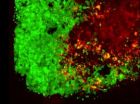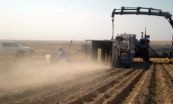(Press-News.org) BUFFALO, N.Y. – People who inject drugs and are enrolled in a drug treatment program are receptive to education about, and treatment for, hepatitis C virus, according to a study by researchers at several institutions, including the University at Buffalo.
That finding, published online this week in the Journal of Addiction Medicine will be welcome news to health care providers. The paper notes that injection drug use is a primary mode of infection, making for an HCV infection prevalence as high as 80 percent among people who inject drugs.
"One of the most important findings of this work is that people who inject drugs do want to be educated about the disease and that education is associated with willingness to be treated," says senior author Andrew H. Talal, MD, professor of medicine in the Division of Gastroenterology, Hepatology and Nutrition at UB and adjunct associate professor of medicine at Weill Cornell Medical College. First author is Marija Zeremski, PhD, senior research associate in medicine at Weill Cornell Medical College and research assistant professor of medicine at UB.
Talal and colleagues previously demonstrated that treatment of addiction significantly enhances the ability of people who use drugs to complete HCV therapy.
"These new findings support the premise that addiction-treatment facilities can help provide sustained HCV treatment for this population," Talal says. "These facilities have the added advantage of being able to link HCV care to drug treatment, allowing for closer patient evaluation, which will likely lead to improved adherence to treatment regimens."
HCV infection often is asymptomatic, but 75 to 80 percent of those infected will develop chronic infection that can progress to liver cirrhosis and/or liver cancer, potentially requiring liver transplantation as a life-saving intervention. However, in order to be considered for a liver transplant, people who use drugs must remain "clean" for at least six months.
The study was based on a survey of 320 patients enrolled in a New York City-based methadone treatment program (START Treatment and Recovery Centers). Nearly half of them reported that they had tested positive for HCV infection.
Seventy-eight percent of respondents expressed willingness to participate in HCV-related education and to receive treatment for HCV. More than half of those surveyed correctly responded to at least five of seven questions assessing their knowledge about HCV.
"People who inject drugs have always wanted to be treated for hepatitis C, but there have been a variety of barriers at the patient, provider and institutional levels," says Talal. "Most importantly, there has been a lack of education about the disease, a fear of side effects of interferon, discomfort in conventional health care venues and a lack of awareness of the status of the infection."
In some cases, the percentage of HCV-infected people who use drugs that show up for HCV-related medical appointments is as low as 10 percent, according to Talal.
In the current research, patients cited fear of side effects from interferon, which remains as part of the standard treatment regimen for genotype 1 infection, as a key barrier to their willingness to accept HCV treatment. Interferon can cause multiple side effects, ranging from fatigue, fever, nausea, anorexia, muscle pain and hair loss, to insomnia, depression and irritability. In addition, interferon-based therapies are only effective in eliminating infection in half of those who take it.
"A major change in the attitudes of people who use drugs is due to knowledge about greatly improved treatment efficacy and the ability to provide HCV treatment at the same site as the substance abuse treatment," says Talal.
Talal adds that the New York State law mandating that all individuals born between 1945 and 1965 be offered HCV screening is increasing the number of people diagnosed with the infection, thereby also making them more receptive to HCV education and treatment.
This study, funded by the Viral Hepatitis Action Coalition and performed in collaboration with the Centers for Disease Control and Prevention, documents the initial phase of a project called Prevention, Evaluation and Treatment of Hepatitis C in Opiate Agonist Treatment (PET-C). Led by Talal, the project's goal is to assess how telemedicine can be used to evaluate a model of HCV treatment for people who inject drugs and are enrolled in a drug treatment program.
Talal conducts research on HCV in UB's Clinical and Translational Research Center and he sees patients as a physician with UBMD, the practice plan of the UB School of Medicine and Biomedical Sciences. He previously served on the advisory board for Abbott Molecular, received support from Gilead Sciences and disclosed a prior relationship with Vertex Pharmaceuticals, all of which helped sponsor the study.
INFORMATION:
Co-authors with Talal and Zeremski are: Rositsa B. Dimova, PhD, of Weill Cornell and UB; Roberto Zavala, MD, Steven Kritz, MD, and Melissa Lin, MS, of START Treatment and Recovery Centers; and Bryce D. Smith, PhD, and Jon E. Zibbell, PhD, of the Centers for Disease Control and Prevention.
A photo of Talal is at http://www.buffalo.edu/news/releases/2014/05/025.html.
Methadone programs can be key in educating, treating HCV patients
More effective, new medications for HCV infection with fewer side effects are also causing a shift in patients' attitudes
2014-05-16
ELSE PRESS RELEASES FROM THIS DATE:
Non-invasive lithotripsy leads to more treatment for kidney stones
2014-05-16
DURHAM, N.C. – When it comes to treating kidney stones, less invasive may not always be better, according to new research from Duke Medicine.
In a direct comparison of shock wave lithotripsy vs. ureteroscopy – the two predominant methods of removing kidney stones – researchers found that ureteroscopy resulted in fewer repeat treatments.
The findings were published May 16, 2014, in the journal JAMA Surgery, coinciding with presentation at the annual meeting of the American Urological Association.
"Nearly one out of 11 people in the United States has kidney stones, ...
Cognitive behavioral or relaxation training helps women reduce distress during breast cancer treatment
2014-05-16
Coral Gables, Fla. (May 16, 2014) – Can psychological intervention help women adapt to the stresses of breast cancer? It appears that a brief, five-week psychological intervention can have beneficial effects for women who are dealing with the stresses of breast cancer diagnosis and surgery. Intervening during this early period after surgery may reduce women's distress and providing cognitive or relaxation skills for stress management to help them adapt to treatment.
Researchers at the University of Miami recruited 183 breast cancer patients from surgical oncology clinics ...
Spiders spin possible solution to 'sticky' problems
2014-05-16
Researchers at The University of Akron are again spinning inspiration from spider silk—this time to create more efficient and stronger commercial and biomedical adhesives that could, for example, potentially attach tendons to bones or bind fractures.
The Akron scientists created synthetic duplicates of the super-sticky, silk "attachment discs" that spiders use to attach their webs to surfaces. These discs are created when spiders pin down an underlying thread of silk with additional threads, like stiches or staples, explains Ali Dhinojwala, UA's H. A. Morton professor ...
With imprecise chips to the artificial brain
2014-05-16
This news release is available in German. Which circuits and chips are suitable for building artificial brains using the least possible amount of power? This is the question that Junior Professor Dr. Elisabetta Chicca from the Center of Excellence Cognitive Interaction Technology (CITEC) has been investigating in collaboration with colleagues from Italy and Switzerland.
Their surprising finding: Constructions that use not only digital but also analog compact and imprecise circuits are more suitable for building artificial nervous systems, rather than arrangements ...
Lighting the way to graphene-based devices
2014-05-16
Graphene continues to reign as the next potential superstar material for the electronics industry, a slimmer, stronger and much faster electron conductor than silicon. With no natural energy band-gap, however, graphene's superfast conductance can't be switched off, a serious drawback for transistors and other electronic devices. Various techniques have been deployed to overcome this problem with one of the most promising being the integration of ultrathin layers of graphene and boron nitride into two-dimensional heterostructures. As conductors, these bilayered hybrids ...
Herpes-loaded stem cells used to kill brain tumors
2014-05-16
Harvard Stem Cell Institute (HSCI) scientists at Massachusetts General Hospital have a potential solution for how to more effectively kill tumor cells using cancer-killing viruses. The investigators report that trapping virus-loaded stem cells in a gel and applying them to tumors significantly improved survival in mice with glioblastoma multiforme, the most common brain tumor in human adults and also the most difficult to treat.
The work, led by Khalid Shah, MS, PhD, an HSCI Principal Faculty member, is published in the Journal of the National Cancer Institute. Shah heads ...
Ataluren Phase 3 trial results in nonsense mutation cystic fibrosis
2014-05-16
SOUTH PLAINFIELD, NJ – May 16, 2014 – PTC Therapeutics, Inc. (NASDAQ: PTCT) today announced that the results of a Phase 3 study of ataluren in patients with nonsense mutation cystic fibrosis (nmCF) were published in Lancet Respiratory Medicine. The results demonstrated positive trends in both the primary endpoint, lung function as measured by relative change in % predicted FEV1 (forced expiratory volume in one second) and in the secondary outcome measure, rate of pulmonary exacerbations. The collective data from this trial, including retrospective and subgroup analyses ...
Glasses-free 3-D projector
2014-05-16
Over the past three years, researchers in the Camera Culture group at the MIT Media Lab have steadily refined a design for a glasses-free, multiperspective, 3-D video screen, which they hope could provide a cheaper, more practical alternative to holographic video in the short term.
Now they've designed a projector that exploits the same technology, which they'll unveil at this year's Siggraph, the major conference in computer graphics. The projector can also improve the resolution and contrast of conventional video, which could make it an attractive transitional technology ...
Growing camelina and safflower in the Pacific Northwest
2014-05-16
A recent study published in Agronomy Journal provides information important to farmers growing oilseed crops. In the study, camelina and safflower were grown in three-year rotations with winter wheat and summer fallow. The study shows that using this rotation may require that no tillage should be done to the soil during the fallow year. Oilseed crops produce relatively little residue—organic material such as roots that hold the soil together. Even light tillage can disintegrate the soil.
A cooperative study by the USDA-ARS and Washington State University researched the ...
How Asian American 'tiger mothers' motivate their children
2014-05-16
An article titled "Why Chinese Mothers Are Superior," published in The Wall Street Journal in 2011, has continued to provoke a cultural debate among parents after self-proclaimed 'tiger mother' Amy Chua asserted that Asian American parenting methods produce more successful children. Researchers at Stanford University delved deeper into Chua's 'tiger mother' approach, and their research sheds light on key fundamental differences in parenting methods between Asian Americans and European Americans.
To reveal the cultural differences in parenting, the researchers compare ...
LAST 30 PRESS RELEASES:
Injectable breast ‘implant’ offers alternative to traditional surgeries
Neuroscientists devise formulas to measure multilingualism
New prostate cancer trial seeks to reduce toxicity without sacrificing efficacy
Geometry shapes life
A CRISPR screen reveals many previously unrecognized genes required for brain development and a new neurodevelopmental disorder
Hot flush treatment has anti-breast cancer activity, study finds
Securing AI systems against growing cybersecurity threats
Longest observation of an active solar region
Why nail-biting, procrastination and other self-sabotaging behaviors are rooted in survival instincts
Regional variations in mechanical properties of porcine leptomeninges
Artificial empathy in therapy and healthcare: advancements in interpersonal interaction technologies
Why some brains switch gears more efficiently than others
UVA’s Jundong Li wins ICDM’S 2025 Tao Li Award for data mining, machine learning
UVA’s low-power, high-performance computer power player Mircea Stan earns National Academy of Inventors fellowship
Not playing by the rules: USU researcher explores filamentous algae dynamics in rivers
Do our body clocks influence our risk of dementia?
Anthropologists offer new evidence of bipedalism in long-debated fossil discovery
Safer receipt paper from wood
Dosage-sensitive genes suggest no whole-genome duplications in ancestral angiosperm
First ancient human herpesvirus genomes document their deep history with humans
Why Some Bacteria Survive Antibiotics and How to Stop Them - New study reveals that bacteria can survive antibiotic treatment through two fundamentally different “shutdown modes”
UCLA study links scar healing to dangerous placenta condition
CHANGE-seq-BE finds off-target changes in the genome from base editors
The Journal of Nuclear Medicine Ahead-of-Print Tip Sheet: January 2, 2026
Delayed or absent first dose of measles, mumps, and rubella vaccination
Trends in US preterm birth rates by household income and race and ethnicity
Study identifies potential biomarker linked to progression and brain inflammation in multiple sclerosis
Many mothers in Norway do not show up for postnatal check-ups
Researchers want to find out why quick clay is so unstable
Superradiant spins show teamwork at the quantum scale
[Press-News.org] Methadone programs can be key in educating, treating HCV patientsMore effective, new medications for HCV infection with fewer side effects are also causing a shift in patients' attitudes





